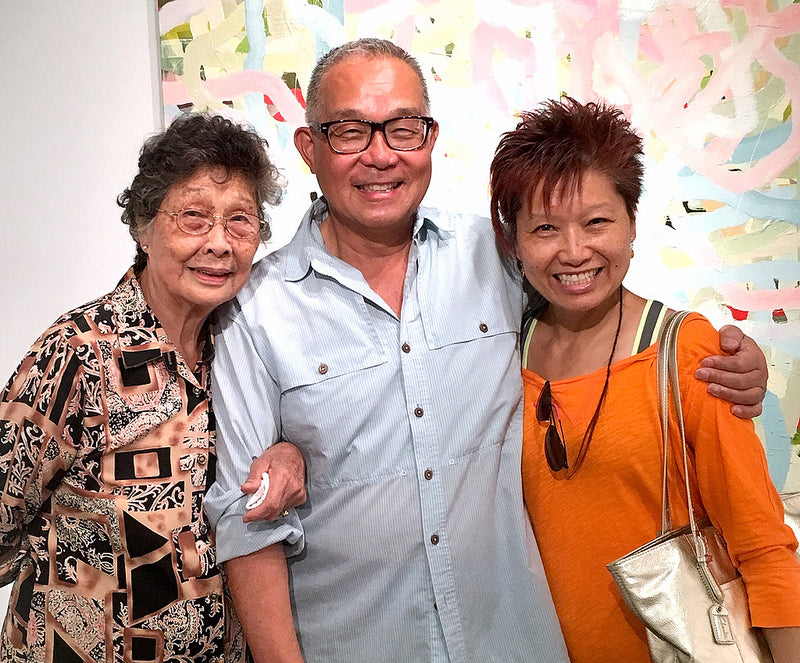
Artists-in-Residence Arlan Huang and Mee Mee Chin: Creating Connections Through Paintings, Performance, and Place
While painter Arlan Huang and amateur Cantonese opera performer Mee Mee Chin are part of the same family, they grew up differently. One American born to American-born parents. One born in China and an immigrant. One from San Francisco and the other from New York. One raised by parents who thought it was fine to be an artist. The other unaware she had the freedom to choose her own career .
But they also have a lot in common. They’re both artists. They’re both close with their families but at the same time feel a distance between themselves and older generations. They both want to close that distance and hope this exhibition will help do that.
We had the chance to talk to our latest artists-in-residence about their backgrounds, how memory plays a part in their work, and how a chance meeting at a subway station led to this exhibition.
Tell me about the first time you met.
Arlan Huang (AH): My family is from San Francisco and we had come to New York to visit. It was 1965 and my first time here. I was 15 and Mee Mee was younger. She and her family were new. They had just come over from Hong Kong.
Mee Mee Chin (MMC): The first time I saw you, I thought you were a hippie. You were already doing the artist thing.
Where were you born, Arlan?
AH: In Bangor, Maine, which is where my father was also born. My mother was born in San Francisco, and that's where I grew up.
How about you, Mee Mee?
MMC: I was born in Guangdong but grew up in Hong Kong. We went to Hong Kong when I was three, and came to America when I was 12 or 13.
Did you see each other regularly after you first met?
AH: The next time was in 1969, after I came here to go to Pratt. We’d see each other at family functions but we weren’t necessarily close. I actually saw her mother more. She lived on Baxter — and still lives in the same place. My grandparents and uncle lived on Mulberry. Mee Mee's father had a laundry next to my grandfather’s store.
Were you both always interested in art in some form or another?
AH: Yes, ever since I was kid. In my generation, being an artist wasn’t frowned upon, but people I knew were still mostly professionals. Lawyers and doctors. My parents, however, were always encouraging.
It was different though with my east coast family. The generation gap between my parents and myself was already large. When I came to New York, I saw that it was even larger between the children and parents. There’s always been this distance between me and my east coast family.
MMC: Yes, that part of the family is more traditional. I’m considered the black sheep of my family. I liked clothing design since I took a sewing class in the eighth grade but my family encouraged me to be a nurse or a secretary. I couldn’t be a nurse — I hate blood! — so I was a secretary. I hated it. It was so boring. I tried different industries. I even tried the movie industry! But I never liked it.
Finally, I decided to go to school [the Fashion Institute of Technology] for fashion design. I told my father, “This is what I’m going to do, whether or not you pay.” But he did pay which was good because I didn’t know how I was going to pay for it!
I worked as a designer for many years. Then I got bored. What you design isn’t the same as what ends up in the store. So I opened my own bridal shop. I did custom bridal gowns. All kinds of weird stuff. The rentals were for the Chinese brides but it was mostly white ladies who wanted custom dresses. One wanted a pocket for cigarettes. I said, “You’re going to smoke while walking down the aisle?” and she said yes.
Then I worked too hard and got sick. So I stopped and sold the place. I adopted my daughter and stayed home as a mom. After my daughter started kindergarten, I started working as a Chinese translator.
When did you first start performing?
MMC: I started learning in 2004 accidentally. The Man Chee Dramatic and Benevolent Association was advertising classes for Cantonese opera. It was the first time in Chinatown. I never did anything like that before. But when I was little, in Hong Kong that was all we saw. I remember my mother’s best friend made her take me to see an opera school. I guess I was about eight. I remember this girl standing there singing. But my mother said no. That stuck in my head.
For a few years I was just “playing.” I’d go once a week. I thought, I can’t sing. In eighth grade I had a singing class. So I did have some training and knew some notes. But after eighth grade, who remembers?
When did performing become more serious for you?
MMC: One day my teacher came up to me and said, “It’s not that you don’t know, you’re just lazy.” I thought, I’m gonna show you! It was around 2010 that I started being more serious. For three months I studied. Every day after work. The musician said, “Wow, what did you do? What happened? You’re so much better.” Then I was hooked.
AH: How did you get this collection of costumes?
MMC: Man Chee was moving. They had been around for 98 years. They were in their building for a long time but they had to move. They had a lot of costumes but had to get rid of some. Some costumes were so old — a hundred years old — they just fell apart. But the ones that didn’t fall apart, I kept.
How did you come up with the idea to do this exhibition together?
AH: I had been doing these paintings on plexiglass. I paint by intuition, but as I was looking at them I thought, These look so familiar. I didn’t know why, but something was hitting a chord.
Once in a while the source comes as an epiphany. And my epiphany was that these were my mother’s cheongsams. The dresses she’d wear to banquets every weekend. She’s always come back with running dots of grease on the dresses. She’d try to clean them but could never really get them all off. My paintings had what looked like the grease spots. They just happened to be there. I had done three paintings when I realized that was the source.
Soon after, I happened to bump into Mee Mee by the subway station as she was coming back from opera practice. She mentioned her costumes, and I thought, I need to see those.
MMC: When I first saw the paintings, it reminded me of the patterns of the costumes. I could tell they were done through a Chinese eye. I thought, Where did he get that from? Then when he saw the costumes, he went crazy.
What do you hope to accomplish through this exhibition?
AH: I've started seeing everything more and more through Asian American eyes, not just American. The soul of this show is seeing us by us. And it's about holding a show in a place where different generations can meet. Pearl River is that place. Family members who are more culturally Chinese don’t understand what I do. They don’t understand what a gallery is and why would you hang art on a wall?
MMC: They wonder, Is someone going to buy that?
AH: Right. My relatives don’t go to my shows. I’m hoping this exhibition brings that distance closer, that it will be more accessible to family. In a context that’s closer to what they know. Having it here in Pearl River and in this gallery makes it closer.
CLOSING THE DISTANCE will be on view in our TriBeCa gallery from Feb. 2 through March 17. Free and open to the public.
[Image: Arlan Huang and Mee Mee Chin with Mee Mee's mother (far left)]
